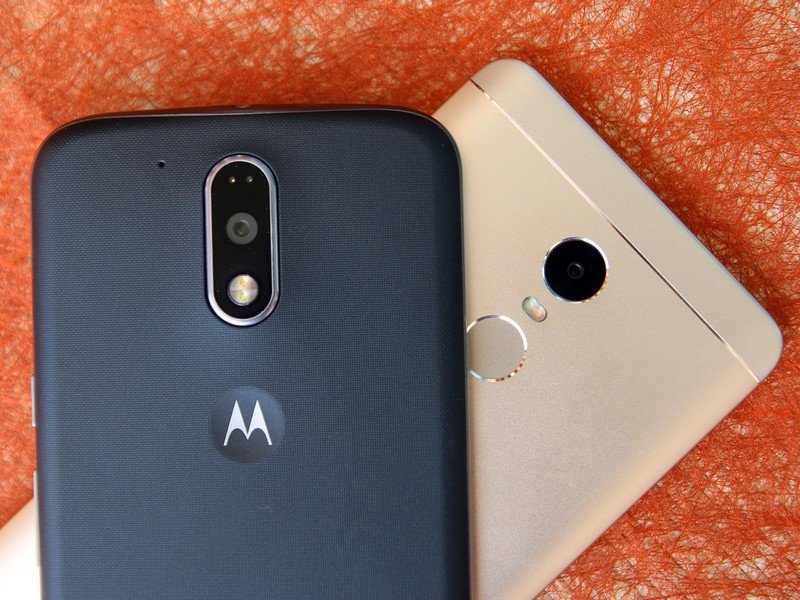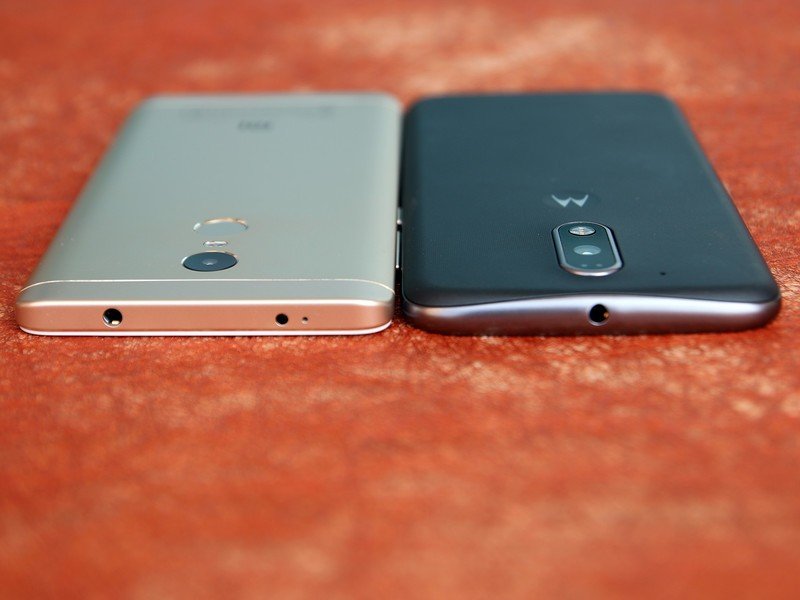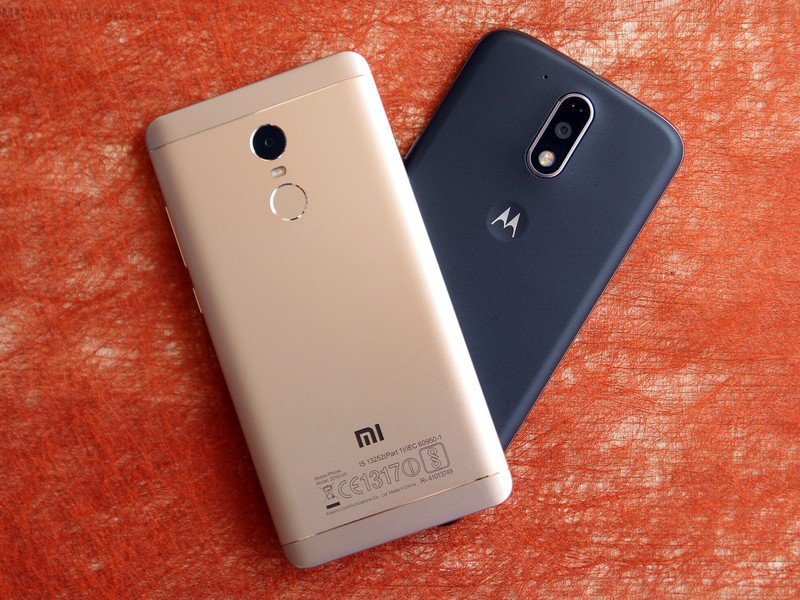Xiaomi Redmi Note 4 vs. Moto G4 Plus: Same price, different strategies

The Moto G series paved the way for affordable phones. The current-generation Moto G4 Plus offers significant upgrades from its predecessor in the form of a fingerprint sensor and a vastly improved camera, while sticking to the same pricing model.
The same holds true for the Redmi Note 4. Xiaomi's meteoric rise in recent years is because of the success of its budget Redmi series, which catapulted the manufacturer to third place in India's handset segment.
The Redmi Note series, in particular, has led the way forward for the brand, with the Redmi Note 3 becoming one of the best-selling phones in the country last year. With the Redmi Note 4, Xiaomi introduced subtle improvements in the imaging and design departments, turning the device into a more compelling handset.
India is Motorola's largest global market, and as such there's a lot at stake. Read on to find out if the Moto G4 Plus can hold its own next to the Redmi Note 4.
Hardware

The Redmi Note 4 has an all-metal aluminum chassis, while the Moto G4 Plus is made out of plastic. The soft touch plastic on the device makes it grippy, but it doesn't look nearly as premium as the Redmi Note 4.
The Moto G4 Plus is also unwieldy to use one-handed. Although both phones offer 5.5-inch displays, the Moto G4 Plus is larger, wider, and thicker than the Redmi Note 4. The larger dimensions wouldn't have been an issue had the device offered more battery capacity, but that isn't the case. The 9.8mm thick Moto G4 Plus has a 3000mAh battery, whereas the Redmi Note 4 fits a 4100mAh battery in a slimmer 8.5mm profile.
Round the back, the Moto G4 Plus has an oblong camera strip that houses the camera sensor and the dual-tone LED flash module. The camera housing protrudes slightly from the back, which leads to a wobble when using the device on a flat surface. The camera module on the Redmi Note 4 sits flush with the body of the device, and the fingerprint sensor is located at the back.
Be an expert in 5 minutes
Get the latest news from Android Central, your trusted companion in the world of Android





The always-on fingerprint sensor on the Redmi Note 4 lets you unlock the device even when the display is switched off. The sensor is quick to authenticate and works well as long as there isn't any moisture on your fingers.
The Moto G4 Plus has a fingerprint sensor at the front, which also lets you unlock the device when the panel is switched off. The square sensor is smaller than those you usually find at the front, but it does a good job of recognizing your fingerprints. That said, the major drawback of the fingerprint sensor on the Moto G4 Plus is that it doesn't double up as a home button. You can use it to unlock the phone, and that's pretty much it. That's a design fail as the sensor takes up valuable real estate at the front, and it would've been a better idea to use a rear-mounted sensor instead.
| Category | Xiaomi Redmi Note 4 | Motorola Moto G4 Plus |
|---|---|---|
| Operating System | MIUI 8 based on Android 6.0.1 Marshmallow | Android 7.0 Nougat |
| Display | 5.5-inch 1080p (1920x1080) IPS LCD panel401ppi pixel density | 5.5-inch 1080p (1920x1080) IPS LCD panel401ppi pixel density |
| SoC | Octa-core Qualcomm Snapdragon 625Eight Cortex A53 cores at 2.0GHz14nm | Octa-core Qualcomm Snapdragon 617Four Cortex A53 cores at 1.5GHzFour Cortex A53 cores at 1.2GHz28nm |
| GPU | Adreno 506 | Adreno 405 |
| RAM | 2GB/3GB/4GB RAM | 2GB/3GB RAM |
| Storage | 32GB/64GB storagemicroSD slot up to 256GB | 16GB/32GB storagemicroSD slot up to 256GB |
| Rear camera | 13MPdual LED flashPDAF | 16MPdual LED flashPDAF |
| Front shooter | 5MP1080p video recording | 5MP1080p video recording |
| Connectivity | Wi-Fi 802.11b/g/n, Bluetooth 4.1 (A2DP), GPS,microUSB, 3.5mm audio jack | Wi-Fi 802.11a/b/g/n, Bluetooth 4.1 (A2DP), GPS,microUSB, 3.5mm audio jack |
| Battery | 4100mAh battery | 3000mAh battery |
| Fingerprint | Rear fingerprint sensor | Front fingerprint sensor |
| Dimensions | 151 x 76 x 8.5mm | 153 x 76.6 x 9.8mm |
| Weight | 175g | 155g |
| Colors | Silver, Gold, Black | Black, White |
There isn't a traditional notification LED light on the Moto G4 Plus — the Redmi Note 4 has one — and you'll have to rely on Motorola's Moto Actions to preview incoming notifications. The Moto G4 Plus also lacks 2.5D curved glass at the front, with the frame jutting out over the outer edge of the panel. While the device has certainly picked up much-needed upgrades when seen against its predecessor, it falls short next to the Redmi Note 4.
On the plus side, the removable back comes with a provision for two SIM card slots and a dedicated slot for the microSD card, allowing you to use two SIM cards and a microSD card at the same time. The Redmi Note 4 has a hybrid slot, which means you can use just one SIM card if you want to expand storage via a microSD card. Though the back cover is removable on the Moto G4 Plus, the battery is sealed.
Aggressive pricing has been Xiaomi's forte from the beginning, and as a result the Redmi Note 4 undercuts the Moto G4 Plus. The base model of the Redmi Note 4 offers 2GB of RAM and 32GB storage, and is available for ₹9,999 ($150). Then there's the model with 3GB of RAM and 32GB storage, which costs ₹10,999 ($165). Xiaomi is also offering a variant with 4GB of RAM and 64GB storage for ₹12,999 ($190), which is one of the best deals in this segment. In contrast, the Moto G4 Plus with 2GB of RAM and 16GB storage costs ₹12,499 ($185), with the model offering 3GB of RAM and 32GB storage available for ₹13,999 ($210).
Software

It's a one-sided contest on the software front in favor of the Moto G4 Plus. Motorola has been offering a pared down UI that's close to vanilla Android for some time now, and the move has worked out very well for the manufacturer. The Moto G4 Plus doesn't come close to the Redmi Note 4 in terms of specs, but the uncluttered UI and Motorola's optimizations give it the edge when it comes to the software.
MIUI has steadily picked up features over the last three years, and as a result, MIUI 8 feels bloated in comparison to Motorola's UI. You get a ton of customizability and several useful features — like Dual Apps and Second Space — but there is a steep learning curve.
Moto G4 Plus has a clean uncluttered UI. Redmi Note 4 does not.
If you want a phone with a clean UI and hassle-free software experience, you should get the Moto G4 Plus. The phone has already picked up the Nougat update, becoming the first phone in the country to do so. Xiaomi is offering a Nougat beta build for the Redmi Note 4, but a stable release is likely some time away.
With Nougat, Motorola rolled out a new one-handed mode, which shrinks the display down for easier one-handed usage. MIUI has offered a similar mode for some time now, which is accessible with a swipe across the navigation keys. As you can imagine, MIUI's implementation is more customizable, and you have the option of shrinking the screen down to 4 inches, 4.5 inches, or 3.5 inches.
Although there isn't a whole lot in the way of customization on the Moto G4 Plus, you do get Motorola's proprietary Moto Actions, a series of gestures that make it easier to interact with the phone. With Moto Actions enabled, you can do a double-twist motion to open the camera, put the phone face down on a surface to activate do not disturb mode, make a chopping motion to toggle the flashlight, and more. There's also a display setting that lets you view incoming notifications without turning on the screen.
Battery life

Battery life on the Redmi Note 4 is outstanding. A 4100mAh battery combined with an energy-efficient 14nm SoC makes the device one of the best in this segment when it comes to battery longevity. It isn't hard to consistently get a screen-on-time of over seven hours from the Redmi Note 4.
The Moto G4 Plus also has a decent battery, and you'll get a day's worth of usage from a single charge. But it doesn't last nearly as long as the Redmi Note 4. That said, the Moto G4 Plus has fast charging in the form of Motorola's TurboPower, which lets you get up to three hours of usage from a 15-minute charge. Fast charging on the Redmi Note 4 is limited to 5V/2A, and you'll have to wait an agonizing two hours for the battery to fully top up.
Camera

With the Moto G4 Plus, the Moto G series finally has a camera that doesn't fail miserably. In fact, its 16MP camera is now one of the best in this segment. The camera app itself is simplistic, but it offers a surprising amount of features. You get toggles for HDR, flash, timer, shooting modes, and for switching between the front and rear cameras, and there's the ability to adjust exposure on the fly. There's also a manual mode that lets you tweak the shutter speed, focus, ISO, exposure, and white balance.
One of the key areas of focus for Xiaomi with the device was the camera, which has been overhauled for the device. The camera doesn't hold up well when it comes to low-light imagery — that's still a limitation for budget devices — but in bright conditions, you'll get great shots from the Redmi Note 4.


Redmi Note 4 on the left, Moto G4 Plus on the right.




Images taken from the Moto G4 Plus offer true-to-life colors, and the camera does a much better job of taking photos in low-light conditions. When it comes to ease of use and image quality, the Moto G4 Plus wins out.
Which should you buy? Redmi Note 4

The Redmi Note 4 wins out when it comes to the overall design and hardware, but MIUI 8 is cumbersome to use. The phone is made for nerds, so if you're comfortable tinkering with MIUI and are looking for tons of customizability, the Redmi Note 4 is a great choice. It offers a lot for its asking price, and is currently the device to beat in the budget segment. Considering the minor difference in retail cost, you should opt for the variant with 4GB of RAM and 64GB storage, which is available for ₹12,999.
The Moto G4 Plus doesn't have a lot of the hardware prowess and is missing a few features, but for the most part, it gets the basics right. You get a decent Full HD panel, all-day battery life, and great camera, all tied together with a software experience that's unmatched in this segment. That said, Motorola is rumored to launch the Moto G5 later this month, so you're better off waiting to see what's on offer with the newer model.

Harish Jonnalagadda is Android Central's Senior Editor overseeing mobile coverage. In his current role, he leads the site's coverage of Chinese phone brands, networking products, and AV gear. He has been testing phones for over a decade, and has extensive experience in mobile hardware and the global semiconductor industry. Contact him on Twitter at @chunkynerd.
